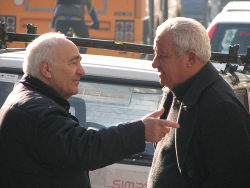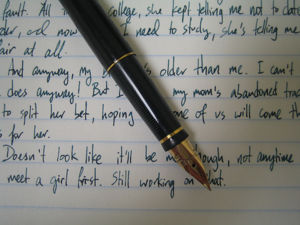Linguistics/Gallery: Difference between revisions
Jump to navigation
Jump to search





imported>John Stephenson (Added acoustic image) |
imported>John Stephenson (More phonetics info) |
||
| Line 15: | Line 15: | ||
[[Image:Chinese-keyboard.jpg|thumb|left|200px|Language may be written using different [[orthography|orthographies]] using modern [[technology]].]] | [[Image:Chinese-keyboard.jpg|thumb|left|200px|Language may be written using different [[orthography|orthographies]] using modern [[technology]].]] | ||
[[Image:Vowels-spectrogram-british-english-adult-male.jpg|thumb|left|500px|Phonetics often involves modern [[technology]] to analyse [[ | [[Image:Vowels-spectrogram-british-english-adult-male.jpg|thumb|left|500px|[[Phonetics]] often involves modern [[technology]] to analyse speech, providing evidence for linguists on the nature of [[spoken language]]. This [[spectrogram]] as used in [[acoustic phonetics]] shows the [[frequency|frequencies]] of vibrations involved in the production of six [[British English]] [[vowel]]s by an [[adult]] [[male]] [[native speaker]]: from left to right, the vowels as in ''bee'', ''sue'', ''herd'', ''or'', ''bar'' and ''buy''. The bands of energy ([[formant]]s) are distinctive for each vowel; for example, the lower the bottom formant ('F1'), the higher the vowel is articulated in the [[mouth]]. The greater the distance between F1 and the second-lowest 'F2' formant correlates with how far back in the mouth the vowel is produced. This image was created using the [http://www.praat.org Praat] freeware program.]] | ||
[[Image:marines-poo-diving-shop-japan.jpg|250px|right|thumb|Why this shop name in [[Japan]]? Linguists also investigate how language is used, but how it is 'abused' is left to others.]] | [[Image:marines-poo-diving-shop-japan.jpg|250px|right|thumb|Why this shop name in [[Japan]]? Linguists also investigate how language is used, but how it is 'abused' is left to others.]] | ||
Revision as of 03:17, 15 July 2007
Presently, this gallery contains images relating to linguistics and language (work in progress!). Please add more.

Stopping and talking is central to human culture.

I love you in American Sign Language.

One reason to study linguistics is its importance in human culture - so important is this urge to communicate that it is often depicted in art.

Phonetics often involves modern technology to analyse speech, providing evidence for linguists on the nature of spoken language. This spectrogram as used in acoustic phonetics shows the frequencies of vibrations involved in the production of six British English vowels by an adult male native speaker: from left to right, the vowels as in bee, sue, herd, or, bar and buy. The bands of energy (formants) are distinctive for each vowel; for example, the lower the bottom formant ('F1'), the higher the vowel is articulated in the mouth. The greater the distance between F1 and the second-lowest 'F2' formant correlates with how far back in the mouth the vowel is produced. This image was created using the Praat freeware program.

Why this shop name in Japan? Linguists also investigate how language is used, but how it is 'abused' is left to others.



